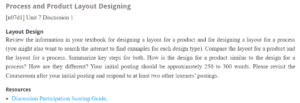Process and Product Layout Designing
Designing for a process layout determines the best relative functional work center location. Work centers that are in frequent interactions with people or material movement should be in close proximity to each other, while those that are not can be separated spatially (Krajewski et al., 2013). The key steps include listing and describing each functional work center; obtaining a drawing of the facility to be designed as well as a description of the same; identifying and estimating the personnel flow and amount of material flow among work centers; use of analytical methods to obtain a general layout that is ideal; and evaluating and modifying the layout while incorporating important details such as equipment access, storage area location, and machine orientation (Krajewski et al., 2013).
Designing for product layout determines the workstation positions for products that are made. Machines are laid sequentially for ease in the transfer of products from one station to another until the final production point. The main steps of product layout design include understanding the order, understanding the output, understanding the timing, and determining the workstations (Bhat & Aswathappa, 2010).
The designs for processes and products are similar in that they both attempt to make the most of the resources in a production line and help workers be more productive (Rowbotham et al., 2012). The product layout differs from a process layout in that the former has specific sections for each group of supplies and tools. The process layout is functional in nature and ensures that all machines that perform similar functions are grouped together (Sanders & Reid, 2016).
References
Bhat, S., & Aswathappa, K. (2010). Production and operations management. Himalaya Publishing House.
Krajewski, L. J., Ritzman, L. P., & Malhotra, M. K. (2013). Operations management. Pearson.
Rowbotham, F., Azhashemi, M., & Galloway, L. (2012). Operations management in context. Routledge.
Sanders, N. R., & Reid, R. D. (2016). Operations management: an integrated approach. John Wiley & Sons.
ORDER A PLAGIARISM-FREE PAPER HERE
We’ll write everything from scratch
Question
Process and Product Layout Designing
[u07d1] Unit 7 Discussion 1
Layout Design

Process and Product Layout Designing
Review the information in your textbook for designing a layout for a product and for designing a layout for a process (you might also want to search the internet to find examples for each design type). Compare the layout for a product and the layout for a process. Summarize key steps for both. How is the design for a product similar to the design for a process? How are they different? Your initial posting should be approximately 250 to 300 words. Please revisit the Courseroom after your initial posting and respond to at least two other learners’ postings.
Resources
- Discussion Participation Scoring Guide.
- UNDERGRADUATE DISCUSSION PARTICIPATION SCORING GUIDE
- Due Date: Weekly
Percentage of Course Grade: 24%.
| Criteria | Distinguished |
| Apply relevant course concepts, theories, or materials correctly. 33% |
Analyzes course concepts, theories, or materials correctly, using examples or supporting evidence. |
| Collaborate with fellow learners, relating the discussion to relevant course concepts. 33% |
Collaborates with fellow learners, relating the discussion to relevant course concepts and extending the dialogue. |
| Apply relevant professional, personal, or other real-world experiences. 34% |
Applies relevant professional, personal, or other real-world experiences to extend the dialogue. |

